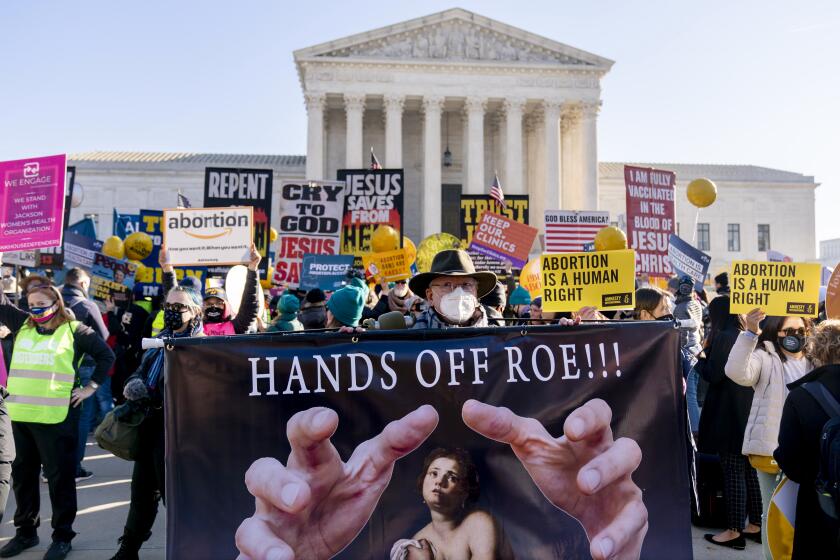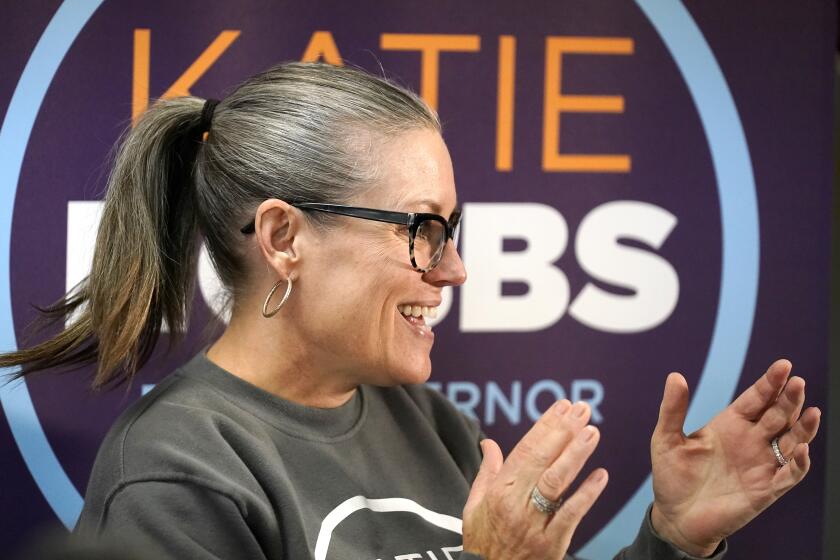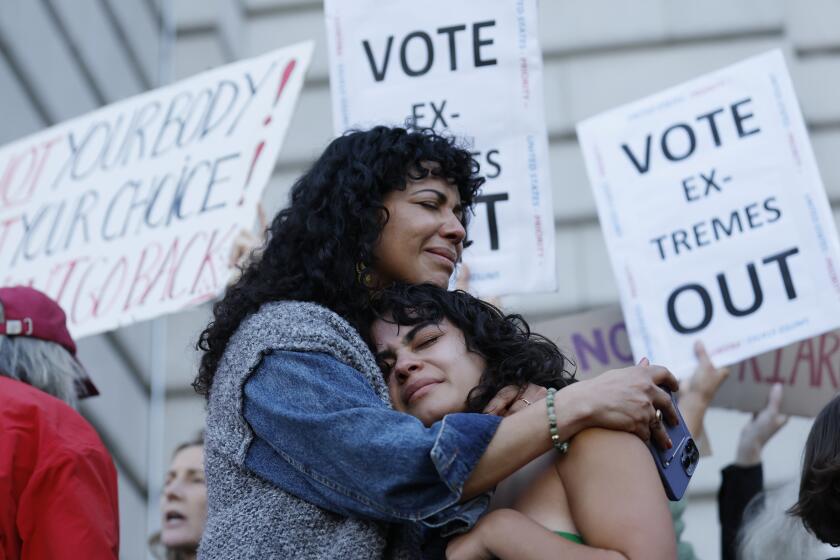Fight over mail ballots continues in key states, will slow election counts

- Share via
HARRISBURG, Pa. — Former President Trump and his allies seized on the drawn-out processing and counting in Pennsylvania during the 2020 election to fuel his false claims that fraud cost him victory in the battleground state.
Election officials worry that a replay could be on the horizon for November’s midterm elections, with high-stakes races on the state’s ballot for governor and U.S. Senate.
And it’s not just Pennsylvania. Michigan and Wisconsin are other crucial swing states that allow no-excuse mail-in ballots but give local election offices no time before election day to process them.
Election workers’ inability to do that work ahead of time means many of the mailed ballots may not get counted on election day, delaying results in tight races and leaving a gaping hole for misinformation and lies to flood the public space.
“That time between the polls closing on election night and the last vote being counted is really being exploited by people who want to undermine confidence in the process,” said Al Schmidt, a Philadelphia election commissioner during the 2020 presidential election who is now president and CEO of the good-government group Committee of Seventy.
The first step in processing mailed ballots, or pre-canvassing, is a routine but crucial administrative task that allows election workers to verify voters’ signatures and addresses, or spot problems that could be fixed by voters. Once ballots are deemed valid, they are removed from their envelopes — another time-consuming task — so they are ready to be counted on election day.
Call it the ‘I don’t know’ election in the fight for Congress. Republicans still have advantages, but Democrats appear energized in the post-Roe environment.
Not in Michigan, Pennsylvania and Wisconsin, vote-count outliers. Thirty-eight other states — including Republican-controlled ones such as Florida, Georgia and Texas — allow mailed ballots to be processed before election day, according to the National Conference of State Legislatures. Florida Gov. Ron DeSantis, a Republican, even brags about producing results on election night — a pointed criticism he made during a recent stop in Pennsylvania.
For the three critical battleground states, such objections fall flat. Efforts since 2020 to give local election workers more time before election day to process mailed ballots have died in Republican-controlled legislatures.
Instead, Republicans in those states have sought to tighten restrictions on voting by mail — provisions vetoed by Democratic governors.
“Counting the ballots should be driven by security, not speed,” Wisconsin state Rep. Janel Brandtjen, a Republican, said this year as lawmakers were considering legislation on the issue. “Why would we want to give bad actors the chance to see ballots prior to election day?”
Republicans helped kill a bipartisan bill that would have allowed more time for processing mailed ballots in Wisconsin amid claims that it would give partisans more time to cheat or leak vote counts early — another unfounded conspiracy theory promoted as a way to explain Trump’s loss.
Like Pennsylvania, election workers in Michigan and Wisconsin must wait until election day to start the pre-canvassing of mailed ballots.
Trump-backed Mehmet Oz faces daily trolling on social media; now his campaign is mocking Democrat John Fetterman over his stroke, as key Senate race heats up.
For now, in Wisconsin and Pennsylvania, requests for absentee ballots are running below 2020’s rate, relieving some of the burden on local election offices.
Still, Claire Woodall-Vogg, executive director of the Milwaukee Election Commission, said it’s “a total guess” when counting will finish in Wisconsin’s most populous county. She hopes it will wrap up by 11 p.m. on election night. A late rush of dropped-off ballots — as happened in 2020 — isn’t expected this year, she said, because courts banned the use of drop boxes.
In Michigan in 2020, lawmakers agreed to give clerks in more populous cities and towns 10 hours on the day before election day to process mailed ballots. Clerks unsuccessfully sought a similar provision for this year.
The Republicans who control the Pennsylvania Legislature have refused to allow early processing of mailed ballots unless it comes packaged with provisions Democrats don’t want, such as banning drop boxes and expanding voter identification requirements.
County election officials say they are grateful the state approved $45 million in election administration grants to help them buy ballot processing equipment and pay for workers to help. But they still face the work of processing well over 1 million mailed ballots just as they are running the November election. A number of them do not expect to finish processing mailed ballots until at least the day after the election — even after working through the night.
Those who advocate for earlier processing say observers can watch the pre-canvassing of mailed ballots, increasing transparency, and note that it is allowed by many other states.
California’s 2022 election ballot includes races for governor, attorney general, Legislature and Congress, local contests and statewide propositions.
“If people want to observe the process,” said Lee Soltysiak, the chief operating officer of Montgomery County in Pennsylvania, “they’re more likely to do it at 3 p.m. and not 3 a.m.”
All three states flipped to support Democrat Joe Biden in the 2020 presidential election and are still being buffeted by conspiracy theories about Trump’s loss — which the former president himself continues to push.
Among those is that election workers falsified ballots in the middle of the night in Philadelphia, Detroit, Milwaukee and other Democratic-leaning cities across battleground states lost by Trump, despite no such evidence emerging for nearly two years since the election.
Death threats to election officials followed the arguing, as did a flurry of litigation designed to keep Trump in office. In the middle of the counting, two men inspired by Trump’s election lies and armed with guns drove from Virginia to where ballots were being tallied in Philadelphia.
More to Read
Get the L.A. Times Politics newsletter
Deeply reported insights into legislation, politics and policy from Sacramento, Washington and beyond. In your inbox twice per week.
You may occasionally receive promotional content from the Los Angeles Times.













